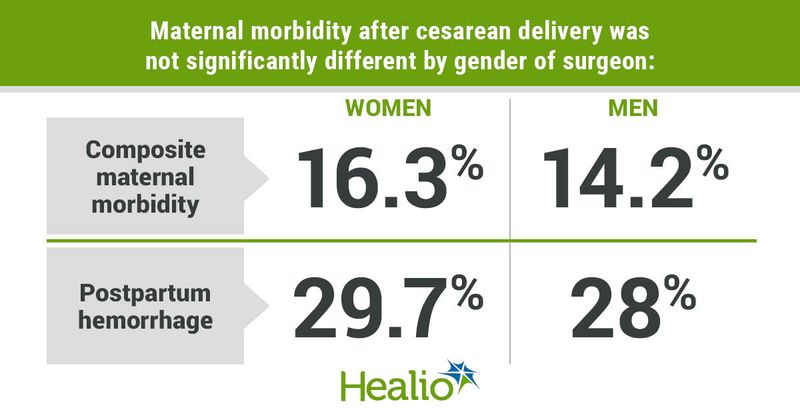Surgeon gender not associated with maternal morbidity after cesarean section
Self-reported gender of surgeons was not associated with risk for maternal morbidity or postpartum hemorrhage after cesarean section, according to findings published in JAMA Surgery.
“We were convinced that women in gynecology-obstetrics worked as well as — or [perhaps] better than — men, contrary to the prejudice that a technical act is better performed by a man than a woman,” Loïc Sentilhes, MD, PhD, chief of OB/GYN at Bordeaux University Hospital in France, told Healio. “However, in obstetrics and gynecology, there was no good data on the subject; we took advantage of an ancillary study of a randomized trial performed in women having a cesarean to test the hypothesis that the maternal morbidity of those women did not differ according to the gender of the operator.”

Sentilhes and colleagues identified women aged 18 years or older from the Tranexamic Acid for Preventing Postpartum Hemorrhage after Cesarean Delivery (TRAAP2) trial who were 34 weeks pregnant and expected to have a cesarean delivery. The TRAAP2 study recruited women delivering at 27 French maternity units from March 2018 to January 2020, who were randomly assigned to tranexamic acid or placebo after delivery.
Following delivery, surgeons reported their gender as man or woman, experience level and information about the procedure in a self-administered questionnaire.
The primary outcome was composite maternal morbidity — which included morbidities such as red blood cell transfusion, emergency surgery for postpartum hemorrhage or hysterectomy, infection and death — within 3 months of delivery. Incidence of postpartum hemorrhage was the secondary endpoint.
In total, 3,928 women were included in analyses for the primary outcome and 4,153 were included in analyses for the secondary outcome. There were 943 (22.2%) cesarean sections performed by men and 3,301 (77.8%) performed by women.
Rates of composite maternal morbidity did not differ between deliveries performed by men (14.2%) and women (16.3%) in crude or adjusted analyses. The components of composite maternal morbidity also did not differ by surgeon gender.
The incidence of postpartum hemorrhage also did not differ by surgeon gender (men, 28% vs. women, 29.7%).
Experience level, type of cesarean delivery and anesthesia type did not influence the associations between surgeon gender and composite maternal morbidity and postpartum hemorrhage.
“Our findings are significant in that they add substantially to the string of studies contradicting the age-old dogma that men are better surgeons than women,” Sentilhes said. “We aim to conduct other studies assessing whether the gender is associated to quality of care in the field of obstetrics and gynecology.”

